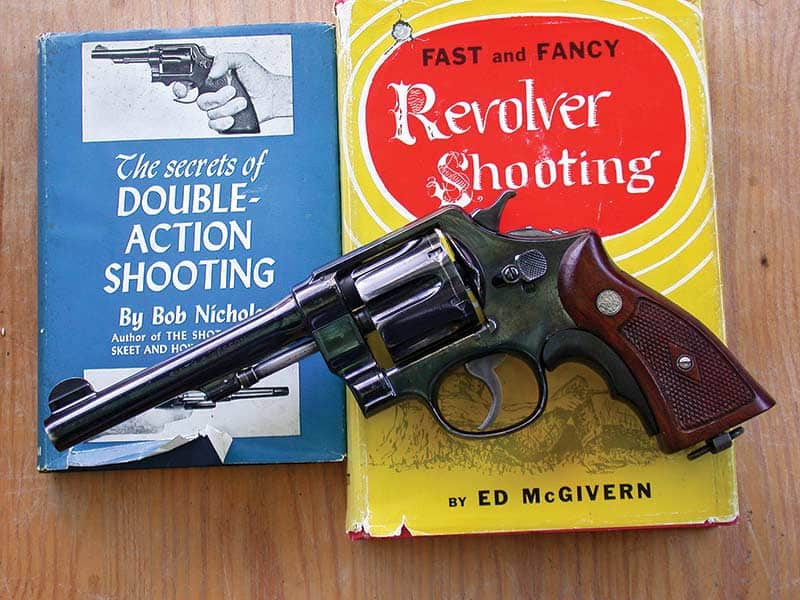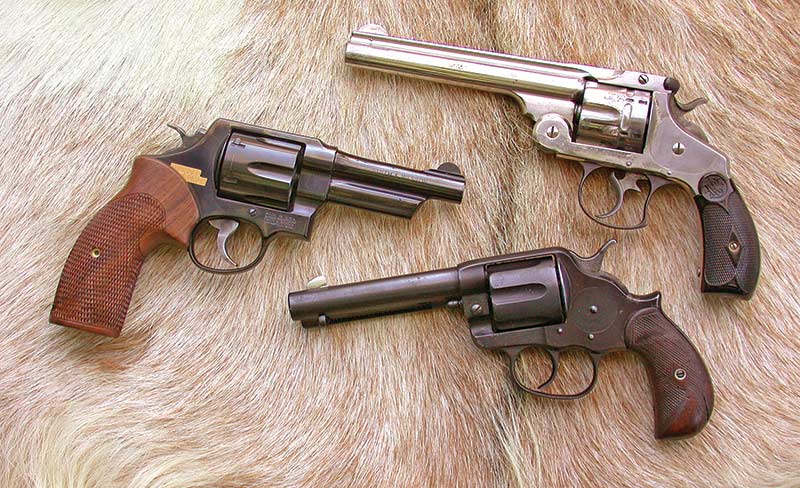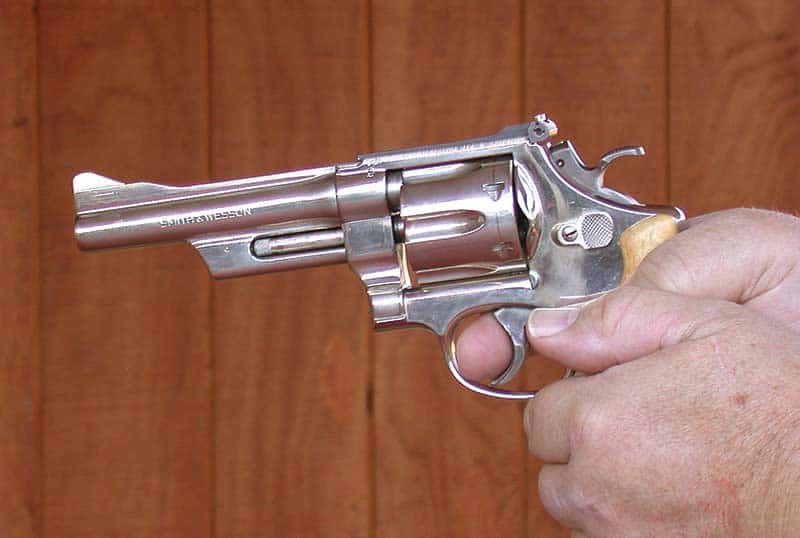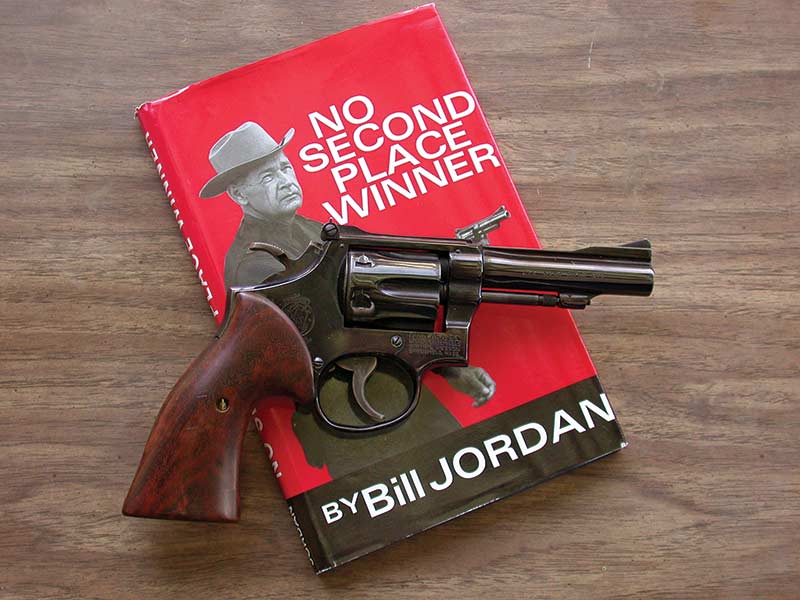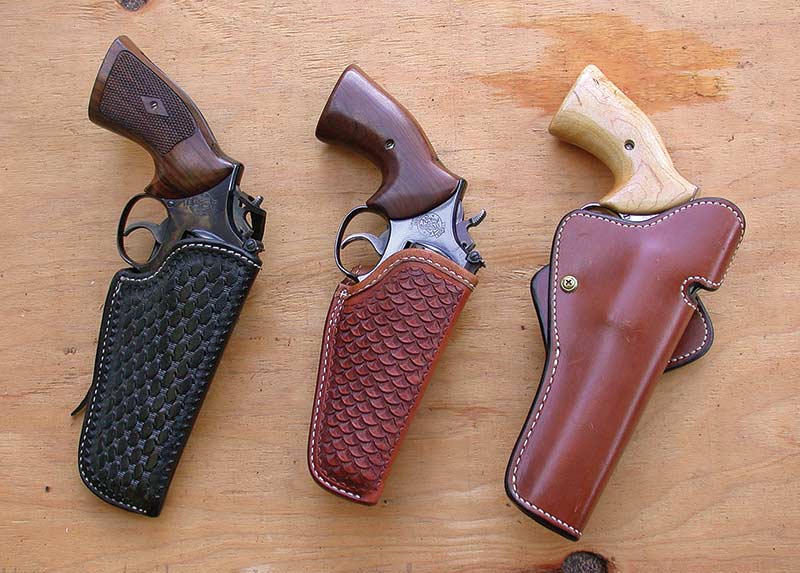Spinning The Wheel
Taffin's 10 Top Tips For Smoking
With The Double Action Sixgun
Arcane in this world of semiautos, the DA revolver is still fun and accurate — especially if you know how to shoot it. My Top Ten Tips for doubleaction sixguns is not necessarily in order of importance, but let us lay down some ground rules first. There are at least six ways to shoot a double-action revolver. We can use a one-handed or two-handed hold, cocking the hammer for a deliberate and carefully aimed shot at paper or game. One-handed or two-handed shooting by pulling the trigger smoothly until the gun fires or, as some have mastered, using a one handed or two-handed method of pulling the trigger until the hammer is cocked and the sixgun is almost ready to fire, pausing then shooting single action. With this method the trigger finger instead of the thumb is used to cock to hammer. It is the most difficult method to master. Here we are concerned with shooting the traditional double-action way, that is, smoothly pulling the trigger until the gun fires. Let’s go to it.
1. Study The Masters
Most of the book-style literature on double-action revolver shooting goes back to the 1930s through the 1950s. The words of the old masters are still relevant today; double-action shooting is double-action shooting in the 19th, 20th or 21st century. Great books on double-action shooting include Ed McGivern’s Fast And Fancy Revolver Shooting (1938), Bob McNichols’ Secrets Of Double-Action Shooting (1950), and Bill Jordan’s No Second Place Winner (1965). Although all of these books are 40 years old or older they still contain valuable information. By reading these masters of double-action shooting you also discover there is no single right way to do things. McGivern was the best double-action shooter who ever shot publicly, at least until Jerry Miculek came along. He was incredible then and is unbelievable now, having broken most of McGivern’s records and setting many of his own. There are many videotapes available of Modern Master Miculek. Again, study and learn.
2. Choose Your Ammunition Carefully
All of McGivern’s double-action sixgun records were set using .38 Specials with his favorite sixguns being the Smith & Wesson Military & Police; when he switched to a single action he still stayed with .38 Specials in a 51⁄2″ Colt Single Action Army. Miculek started using .38 Specials and now uses both .38s and .45 ACPs in heavy-barreled S&W revolvers. For one just starting out, an excellent choice is a 4″ .22 LR S&W Model 18 Combat Masterpiece. This gun is long out of production, however, it is relatively easy to find in the used gun market and Smith & Wesson currently offers a 10-shot heavy-barreled version. Two other excellent choices for use with .38 Special loads are the 4″ K-frame Model 15 Combat Masterpiece found in .38 Special and also the 4″ Model 19 .357 Combat Magnum. Low-recoiling .38 wadcutters are excellent for learning double-action sixgunning. Moving up the ladder caliber wise, the 4″ Model 24 .44 Special or the 4″ Model 29 .44 Magnum both used with standard .44 Special loads using a 250-grain bullet at 750 fps exhibit more recoil than the 38s, but are still easily controlled as is the same sixgun chambered in .45 ACP or .45 Colt — again using standard loads. The .44 Magnum may be fine for the first shot, however triggering off a cylinder full is not a pleasant experience. My first preference for double-action shooting is the Smith & Wesson revolver, others may place the Colt, Ruger, or Taurus in first place. Whatever feels right is the right choice.
3. Avoid The Original Old Double Actions
I really like shooting the single-action and double-action sixguns of the 19th century. They are for black-powder loads only and are a great connection to our history. If I had to defend myself with either the Colt Model 1878 or the Smith & Wesson Top-Break DA .44, I know it could be accomplished, but there are much better choices. Ditto the early top-break pocket revolvers chambered in .32 S&W and .38 S&W. By the time of World War I, both Colt and Smith & Wesson were offering state-of-the-art double-action sixguns. Colt no longer offers a double-action revolver, but the Colt Python is still an excellent choice. The finest double-action mechanisms ever offered are the “long actions” of the pre-World War II Smith & Wessons. The .38-44 Heavy Duty and .357 Magnum were especially easy to shoot as their heavy cylinders dampened recoil and picked up inertia making them almost “self-shooting.” Unfortunately, in the 1930s and 1940s the number one handgun sport was bull’s-eye shooting and the favorite DA revolver for shooting single-action-style on paper was the Colt. To make the Smith more popular with paper punchers, it was fitted with a short action allowing easier cocking when used single-action. As a result, the old, smooth, long action was lost. Fortunately post-war short-action Smiths run a close second.
4. Choosing A Grip Frame
When the only choice shooters had was found among Colt and Smith & Wesson DA revolvers (excepting the pocket pistols), sixgunners had four choices, Colt’s New Service (large) and Python (medium) and S&W’s N-frame (large) and K-frame (medium). Today there are many more choices making selection not quite so easy, however, on the upside, it is much more likely a shooter will find a grip best suited to his hand size and shooting style. S&W still offers large and medium grip frames, as does Ruger, Taurus and Dan Wesson. The Ruger GP-100 and all the Dan Wessons do not have a grip frame, but rather a stud accepting a wraparound grip. For the shooter with very small hands one of these revolvers might well be the best choice.
5. Coming To Grip with Grips
In spite of so many choices, for me, a custom grip is necessary for the best possible DA shooting. When the only choice we had was Colt and S&W, I found it was impossible to satisfactorily stock a Colt grip to me. The Smith & Wesson N-frame was much easier to stock properly, and the S&W K-frame and Lframe is the best of all — especially stocked with the Walter Roper/Skeeter Skelton-style grips offered by BluMagnum, Eagle Grips, Roy Fishpaw and Herrett’s. The former is the closest to Skeeter’s recommendation, the latter to Roper’s specs, and the other two somewhere in between. The best-case is to somehow be able to try them all.
It is much easier today for someone to find the perfect grip frame/grip combination. Whatever your hand size, custom grips can easily be made to actually fit because most frames are either round-butt, such as most Smith & Wessons or have studs to accept a grip block as furnished by Dan Wesson and Ruger on their GP-100 and Super Redhawk. This allows almost any size grip to be whittled to size. Factory grips are also much more useable than those formerly found in the 1980s as most grips now furnished are rubber. They certainly aren’t pretty but they are highly functional. Whatever grip, if it allows the revolver to fit squarely in the hand between thumb and forefinger with an imaginary straight line running down the forearm and through the revolver’s barrel, satisfactory DA results will come much quicker.
6. Gripping A Double-Action Revolver
How one grips a double-action revolver depends upon stock style and size, hand size and training. There is no one way to do it right. What is most comfortable for each individual is also usually the best. Basically, I grip a DA revolver so all three fingers are wrapped around the grip and my thumb is curled around to make contact with the middle finger. The pad of my trigger finger is placed solidly on the trigger. Some advocate using the joint of the trigger finger for shooting double-action, however, if I try this with most double action revolvers, my short stubby fingers will cant the barrel to the right.
Remember the imaginary line through the forearm and down the barrel? By keeping this line straight it is also much easier to point shoot without using the sights. For a two-handed hold I simply bring the left hand up and form a cup for the last three fingers of my shooting hand. Again the forearm-through-barrel-line is kept straight for easy pointing.
7. DA Triggers, Timing And Tuning
We have standard triggers, wide target triggers, grooved triggers and smooth triggers. Again it all comes down to what is most comfortable for you. I have tried them all and I still find the one giving me the best results is the standard-width trigger totally smooth with no sharp edges. This smoothness allows my finger to move with the trigger. One of my favorite double-action sixguns is a Smith & Wesson .44 Magnum Elmer Keith Commemorative tuned by Bob Munden with a smoothed and rounded trigger. Used with standard .44 Special loads it suits me just fine with no trigger finger bite. There was a time I thought the wide target triggers and target hammers found on deluxe Smith & Wesson sixguns to be the best imaginable. Over the years, I’ve learned differently and now prefer standard triggers and hammers. There was a time I also thought red ramp front sights and white outline rear sights were a top choice. For my eyes, black on black is now preferred.
There was a time you could expect a sixgun to be perfectly timed and tuned from the box. Those days are gone and most factory-produced revolvers — if not all — whether single action or double action will benefit from the touch of a master tune smith. The object is smoothness not lightness — tuning is accomplished by carefully stoning contact surfaces, not by lightning springs. An empty gun may seem to work perfectly well with lights springs, but misfires easily occur with reduced power mainsprings. When it comes to a revolver upon which I may bet my life, I want full-power springs. The top gunsmiths put heavier than normal main springs in revolvers designed for hunting. A 100-percent reliable self-defense revolver is even more important than a hunting handgun.
8. Practice Still Makes Perfect
The best way to learn is to shoot double action. Several years ago my youngest grandson inherited his other grandfather’s S&W .38 Special M&P Heavy Barrel. I had it refinished and restocked for him and from the very beginning have taught him to shoot it only double action. By the time he is in his early 20s, he should be a very accomplished DA shooter.
Start with large targets up close practicing point shooting. As the targets are farther away point shooting is replaced by using the sights. I point shoot up to about 21′, then switch to sights. Today we have a great aid for point shooting — Crimson Trace Laser Grips. Activated by a button as the gun is gripped, it places a red dot on the target. It becomes more natural to point correctly and is definitely a great benefit learning DA shooting.
9. Shuckin' Shells
“The way we train is the way we will react when the time comes.” Where have I heard this before? Those of us who reload can easily fall into bad habits simply because we are trying to save brass. I have to be careful in a hunting situation as I will take the time to retrieve a fired case and put in my pocket. This being frugal with brass can be disastrous when shooting DA revolvers in a serious situation, as it is very easy to catch a fired case under the ejector rod star with .45 Colt cases being the most likely to hang up.
The best way to prevent this is to point the barrel skyward and give sharp downward tap on the ejector rod so gravity aids in ejecting spent shells. When testing DA sixguns I used to hold the revolver in my hand horizontally dropping the ejected fired case into my left-hand. Bad training! When I now shoot double-action revolvers I always use the vertical method to remove spent shells dumping them into a box. How we train is how we will react when the time comes.
10. DA Sixgun Leather
In 1920, lawman Tom Threepersons developed the holster still bearing his name today. With slight modifications it has been made by the millions for both single-action and double-action revolvers and by such companies as S. D. Myres, George Lawrence, El Paso Saddlery and Bianchi Leather. Walt Ostin makes a beautiful rendition of the original design for both single- and double action sixguns. It is simplicity itself with no leather not needed. The hammer and trigger are fully exposed with the front part of the triggerguard resting on a wide welt at the back into the holster. No back flaps, no safety straps, nothing to get in the way of a quick draw.
If it has been improved the improvements are found in Milt Sparks’ No. 200AW, which adds a leather covering around the hammer to prevent it from wearing out the lining of a jacket and a tension- adjustable welt to provide security without the need for a safety strap. Both the original and the modern versions ride high and tight on the belt providing easy access and a smooth draw. Some advocate starting to pull the trigger as the sixgun is drawn. I prefer not to do this. There is plenty of time for smooth double-action triggering after the sixgun is on target. Pick a suitable sixgun, have the action smoothed, fitted with personal, custom stocks, add a proper holster and let the games begin. You might be surprised at how easily you can achieve results.

Get More Revolver Content Every Week!
Sign up for the Wheelgun Wednesday newsletter here:
